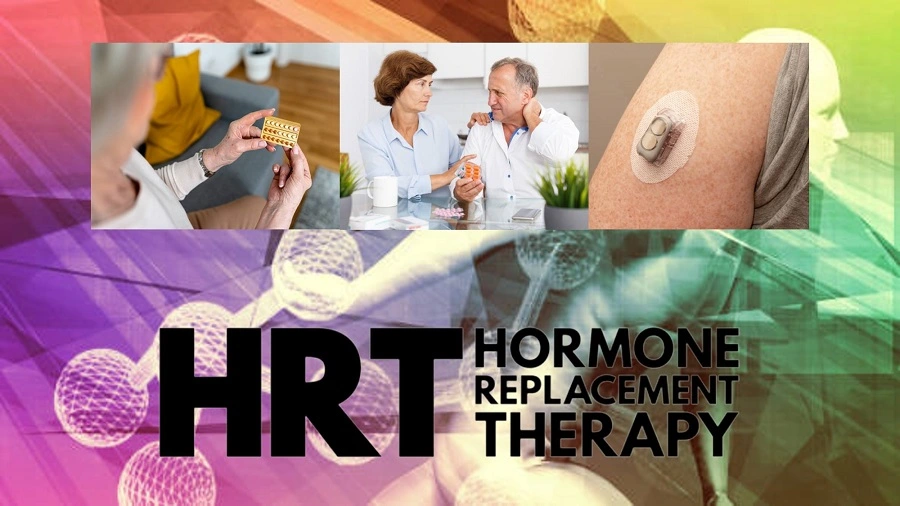
Introduction:
Hormones play a fundamental role in the intricate tapestry of human health and vitality, serving as messengers that regulate various bodily functions. As individuals journey through life, hormone imbalances can disrupt this delicate equilibrium, leading to a range of physical and emotional challenges. This is where Hormone Replacement Therapy (HRT) emerges as a transformative approach, offering a path toward restoring hormonal harmony and enhancing well-being.
In this comprehensive exploration, we delve into two distinct aspects of HRT that have garnered significant attention: its role in navigating the challenges of menopause in women and its potential to optimize testosterone levels in men. Therefore, from the transformative effects on quality of life to the considerations and benefits, join us on this journey to uncover the multifaceted realm of Hormone Replacement Therapy for women and men.
Also Read: Aging And Hormones: Menopause & Andropause, And Their Hidden Similarities
Hormone Replacement Therapy (HRT)
Hormone Replacement Therapy (HRT) constitutes a medical treatment that involves the supplementation or replacement of hormones within the body. Typically, these hormones encompass estrogen and progesterone among women and testosterone among men. This therapy aims to rectify imbalances within the body’s hormonal composition. Furthermore, it manages symptoms of specific conditions and mitigates hormonal shifts from aging, medical procedures, or health circumstances.
In women, the employment of HRT frequently revolves around symptom management during menopause. which encompasses occurrences like hot flashes, night sweats, vaginal dryness, and mood fluctuations. Estrogen and progesterone take precedence as the hormones of choice for women undergoing HRT.
Conversely, in men, Hormone Replacement Therapy, particularly testosterone replacement therapy (TRT), serves to counteract low levels of testosterone (hypogonadism). The decline in testosterone levels can manifest due to aging or certain medical conditions. Indications of low testosterone encompass diminished libido, fatigue, muscle loss, and mood alterations.
The implementation of HRT spans diverse methodologies, including oral pills, patches, gels, injections, and implants. The particular approach adopted hinges on an individual’s necessities, medical background, and personal preferences.
Hormone Replacement Therapy and Menopause
Menopause is a natural biological process that occurs as a woman’s reproductive system changes. It leads to a decrease in the production of hormones such as estrogen and progesterone. This hormonal shift can result in various physical and emotional symptoms.
Furthermore, HRT involves the use of synthetic hormones (estrogen and/or progesterone) to replace the declining hormone levels in the body. By restoring hormone levels, HRT aims to alleviate or reduce the severity of menopausal symptoms.
Some of the common symptoms that HRT can help manage menopausal conditions include:
- Hot Flashes and Night Sweats: These sudden sensations of heat and sweating are among the most common menopausal symptoms. HRT can help alleviate the frequency and intensity of hot flashes and night sweats.
- Vaginal Dryness: Declining estrogen levels can lead to vaginal dryness, discomfort during intercourse, and an increased risk of vaginal infections. Vaginal estrogen therapy, a form of HRT, can help improve vaginal health.
- Mood Changes: Hormonal fluctuations during menopause can contribute to mood swings, irritability, and even symptoms of depression. HRT may help stabilize mood and improve overall well-being.
- Sleep Disturbances: HRT may help improve sleep quality by reducing factors like night sweats and discomfort that can interfere with sleep.
- Bone Health: Estrogen plays a crucial role in maintaining bone density. HRT may help reduce the risk of osteoporosis and fractures associated with declining estrogen levels.
Hormone replacement therapy to improve testosterone in men
Hormone Replacement Therapy (HRT) can be used to improve testosterone levels in men who have been diagnosed with low testosterone, a condition known as hypogonadism. Low testosterone levels can lead to a range of symptoms, including reduced libido, fatigue, mood changes, and changes in muscle mass and bone density. HRT for improving testosterone levels in men involves the administration of synthetic testosterone to bring their hormone levels back into a healthy range.
Here are some key points about using HRT to improve testosterone in men:
- Diagnosis: Before considering HRT, a healthcare provider will conduct a thorough evaluation. They can assess your specific situation, discuss the potential benefits and risks, and guide you in making an informed decision. This may include blood tests to measure testosterone levels and assess symptoms. The diagnosis of low testosterone is based on clinical criteria in addition to laboratory results.
- Treatment Options: There are different forms of testosterone replacement therapy available, including injections, patches, gels, nasal gels, and implants. The choice of treatment method depends on factors such as patient preference, convenience, and medical considerations.
- Benefits: HRT can help alleviate symptoms associated with low testosterone, such as improved libido, increased energy levels, and enhanced mood. It may also contribute to the maintenance of bone density and muscle mass.
- Monitoring: Regular follow-up appointments and monitoring of testosterone levels are essential to ensure that the therapy is effective and safe. Adjustments to the treatment regimen may be made based on individual responses.
- Risks and Considerations: While HRT can provide significant benefits, it’s important to be aware of potential risks and side effects. These can include an increased risk of certain health conditions, such as cardiovascular issues, and the potential impact on fertility. Your healthcare provider will discuss these considerations and help you make an informed decision.
- Individualized Approach: HRT is personalized to each individual’s needs, considering factors such as age, overall health, and specific symptoms. The goal is to optimize testosterone levels while minimizing potential risks.
- Lifestyle Factors: In addition to HRT, lifestyle modifications such as regular exercise, a balanced diet, and stress management can also contribute to overall hormonal health.
Conclusion:
In the realm of wellness and vitality, Hormone Replacement Therapy stands as a beacon of hope for individuals seeking to address the profound impact of hormonal imbalances. From the complex terrain of menopause in women to the intricate interplay of testosterone in men, HRT offers a pathway to rejuvenation and empowerment. As medical science continues to evolve, it is imperative to approach Hormone Replacement Therapy with informed awareness, guided by healthcare professionals, to ensure tailored solutions that harmonize with individual needs and goals.
Whether embarking on the menopausal phase or aiming to optimize testosterone levels, the journey toward well-being is enriched by the possibilities that Hormone Replacement Therapy brings forth. Hence, embracing the potential of HRT is an affirmation of the human spirit’s resilience and the pursuit of a life lived to the fullest, with hormones in harmonious balance.


Pingback: Empower Your Hormones: Unveiling HRT Alternatives for Wellness
Pingback: HRT Side Effects: Pioneering Hormonal Harmony for Men and Women
Pingback: From Hormonal Balance to Bedroom Bliss: HRT and Sexuality
Pingback: Aging And Hormones: Menopause & Andropause, And Their Hidden Similarities
Pingback: Budgeting for Wellness: Deciphering HRT Cost and Its Influences